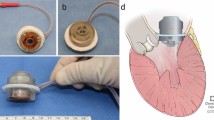Abstract
Implantation of a total artificial heart (TAH) is one of the therapeutic options for the treatment of patients with end-stage biventricular heart failure. There is no report on the hemodynamics of the functional centrifugal-flow TAH with functional atrial contraction (fCFTAH). We evaluated the effects of pulsatile flow by atrial contraction in acute animal models. The goats received fCFTAH that we created from two centrifugal-flow ventricular assist devices. Some hemodynamic parameters maintained acceptable levels: heart rate 115.5 ± 26.3 bpm, aortic pressure 83.5 ± 10.1 mmHg, left atrial pressure 18.0 ± 5.9 mmHg, pulmonary pressure 28.5 ± 9.7 mmHg, right atrial pressure 13.6 ± 5.2 mmHg, pump flow 4.0 ± 1.1 L/min (left) 3.9 ± 1.1 L/min (right), and cardiac index 2.13 ± 0.14 L/min/m2. fCFTAH with atrial contraction was able to maintain the TAH circulation by forming a pulsatile flow in acute animal experiments. Taking the left and right flow rate balance using the low internal pressure loss of the VAD pumps may be easier than by other pumps having considerable internal pressure loss. We showed that the remnant atrial contraction effected the flow rate change of the centrifugal pump, and the atrial contraction waves reflected the heart rate. These results indicate that remnant atria had the possibility to preserve autonomic function in fCFTAH. We may control fCFTAH by reflecting the autonomic function, which is estimated with the flow rate change of the centrifugal pump.



Similar content being viewed by others
References
Roger VL, Go AS, Lloyd-Jones DM, Adams RJ, Berry JD, Brown TM, Carnethon MR, Dai S, de Simone G, Ford ES, Fox CS, Fullerton HJ, Gillespie C, Greenlund KJ, Hailpern SM, Heit JA, Ho PM, Howard VJ, Kissela BM, Kittner SJ, Lackland DT, Lichtman JH, Lisabeth LD, Makuc DM, Marcus GM, Marelli A, Matchar DB, McDermott MM, Meigs JB, Moy CS, Mozaffarian D, Mussolino ME, Nichol G, Paynter NP, Rosamond WD, Sorlie PD, Stafford RS, Turan TN, Turner MB, Wong ND, Wylie-Rosett J. Heart disease and stroke statistics—2011 update: a report from the American Heart Association. Circulation. 2010;123:e18–209.
Mehra MR, Kobashigawa J, Starling R, Russell S, Uber PA, Parameshwar J, Mohacsi P, Augustine S, Aaronson K, Barr M. Listing criteria for heart transplantation: International Society for Heart and Lung Transplantation guidelines for the care of cardiac transplant candidates—2006. J Heart Lung Transplant. 2006;25:1024–42.
Rose EA, Gelijns AC, Moskowitz AJ, Heitjan DF, Stevenson LW, Dembitsky W, Long JW, Ascheim DD, Tierney AR, Levitan RG, Watson JT, Meier P, Ronan NS, Shapiro PA, Lazar RM, Miller LW, Gupta L, Frazier OH, Desvigne-Nickens P, Oz MC, Poirier VL. Long-term use of a left ventricular assist device for end-stage heart failure. N Engl J Med. 2001;345:1435–43.
Kirklin JK, Naftel DC, Pagani FD, Kormos RL, Stevenson L, Miller M, and Young JB, Long-term mechanical circulatory support (destination therapy): on track to compete with heart transplantation? J Thorac Cardiovasc Surg. 2012;144:584–603; discussion 597-8.
Kirklin JK, Naftel DC, Pagani FD, Kormos RL, Stevenson LW, Blume ED, Miller MA, Timothy Baldwin J, Young JB. Sixth INTERMACS annual report: a 10,000-patient database. J Heart Lung Transplant. 2014;33:555–64.
Friedline K, Hassinger P. Total artificial heart freedom driver in a patient with end-stage biventricular heart failure. AANA J. 2012;80:105–12.
Terracciano CM, Miller LW, Yacoub MH. Contemporary use of ventricular assist devices. Annu Rev Med. 2010;61:255–70.
Slaughter MS, Rogers JG, Milano CA, Russell SD, Conte JV, Feldman D, Sun B, Tatooles AJ, Delgado RM III, Long JW, Wozniak TC, Ghumman W, Farrar DJ, Frazier OH. Advanced heart failure treated with continuous-flow left ventricular assist device. N Engl J Med. 2009;361:2241–51.
Frazier OH, Cohn WE, Tuzun E, Winkler JA, Gregoric ID. Continuous-flow total artificial heart supports long-term survival of a calf. Tex Heart Inst J. 2009;36:568–74.
Moazami N, Fukamachi K, Kobayashi M, Smedira NG, Hoercher KJ, Massiello A, Lee S, Horvath DJ, Starling RC. Axial and centrifugal continuous-flow rotary pumps: a translation from pump mechanics to clinical practice. J Heart Lung Transplant. 2013;32:1–11.
Shiga T, Kuroda T, Tsuboko Y, Miura H, Shiraishi Y, Yambe T. Hemodynamic effects of pressure–volume relation in the atrial contraction model on the total artificial heart using centrifugal blood pumps. Conf Proc IEEE Eng Med Biol Soc. 2013;2013:1815–8.
Murray KD, Binkley PF, Watson KM, Howanitz EP, Ross P Jr, Myerowitz PD. Remnant atrial function in human and animal recipients of a total artificial heart. J Heart Lung Transplant. 1992;11:1066–72.
Sato M, Tasaki I, Annaka A. Studies on the metabolism of dairy goat. III Deciding the formula for calculating the body surface aria. Nihon Chikusan Gakkaiho. 1954;25:25–9.
Kobayashi M, Horvath DJ, Mielke N, Shiose A, Kuban B, Goodin M, Fukamachi K, Golding LA. Progress on the design and development of the continuous-flow total artificial heart. Artif Organs. 2012;36:705–13.
Timms D, Fraser J, Hayne M, Dunning J, McNeil K, Pearcy M. The BiVACOR rotary biventricular assist device: concept and in vitro investigation. Artif Organs. 2008;32:816–9.
Tanaka A, Yoshizawa M, Abe K, Takeda H, Yambe T, Nitta S, Abe Y, Chinzei T, Imachi K. Open-loop analysis of transfer characteristics from blood pressure to heart rate using an effectively total artificial heart. Artif Organs. 2004;28:109–14.
Abe Y, Ishii K, Isoyama T, Saito I, Inoue Y, Ono T, Nakagawa H, Nakano E, Fukazawa K, Ishihara K, Fukunaga K, Ono M, Imachi K. The helical flow pump with a hydrodynamic levitation impeller. J Artif Organs. 2012;15:331–40.
Acknowledgments
This study was presented at the European Society of Intensive Care Medicine, LIVES 2013 26th annual congress in Paris, France.
Author information
Authors and Affiliations
Corresponding author
Ethics declarations
Conflict of interest
The authors, T.Y. and Y.S., have conflicts of interest in collaboration with Sun Medical Technology Research Corporation. The other authors declare that they have no conflict of interest.
Rights and permissions
About this article
Cite this article
Shiga, T., Shiraishi, Y., Sano, K. et al. Hemodynamics of a functional centrifugal-flow total artificial heart with functional atrial contraction in goats. J Artif Organs 19, 8–13 (2016). https://doi.org/10.1007/s10047-015-0852-y
Received:
Accepted:
Published:
Issue Date:
DOI: https://doi.org/10.1007/s10047-015-0852-y




